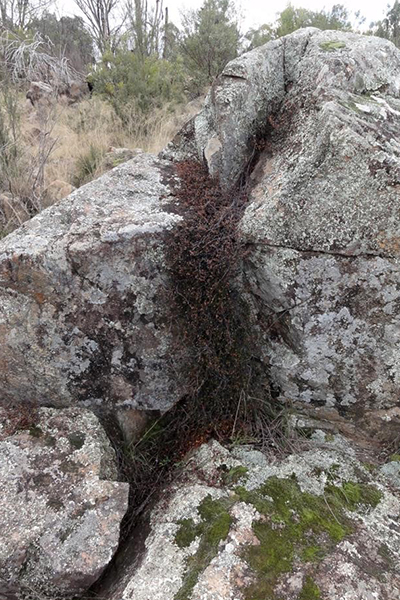Tuggeranong Lignum (Muehlenbeckia tuggeranong)

The Tuggeranong Lignum (Muehlenbeckia tuggeranong) was listed as an endangered species in the ACT in August 1998 and has Special Protection Status as a native species. It is also listed as endangered nationally.
The species is found on flood terraces, at an altitude of about 550 metres, in areas of rocky outcrops with pockets of silty sandy soil. It grows on nearly bare rock, or tangled amongst other vegetation. Since being discovered, this hardy species has tolerated being covered with silt and woody debris during floods and burnt in fires, including severe bushfires in 2003. It survived the Millenium Drought.
The sprawling shrub grows into a mounded, loosely tangled mass approximately 1 metre high and 1–2 metres across. Flowers are cream–green. Plants are mostly unisexual, that is either male or female, with only one female plant found. This plant is not known to have ever set seed.
The plant does grow readily from cuttings but it is not yet known if it disperses vegetatively in the wild. Attempts to translocate plants have had limited success, with close to a dozen individuals still surviving five years post translocation.
Conservation threats
The species' ability to sexually reproduce appears to be very limited, particularly given the only female plant in the wild has not been known to have ever produced seed. It is also likely that genetic variation in the population is very restricted due to the extremely low population size.
The plants are also at risk from flooding, fire, recreational activity, weeds and weed control, and grazing by macropods and rabbits.
Although weeds are possibly the largest management problem in the Murrumbidgee River Corridor and often dominate the groundcover around the Tuggeranong Lignum population, it appears some weeds have replaced native grasses in providing support for the plant’s wiry stems, hiding the plant from possible grazers and sheltering the plant from weather extremes. Other weeds that threaten the plant are regularly removed.
Because the species is impacted by grazing, particularly by kangaroos and wallabies, mesh cages have been erected around the plants, proving effective in improving the condition of individual plants.
Conservation actions
With only 11 plants known to exist in the wild, it is extraordinarily important to protect and conserve this species, including by breeding more plants for translocation, research and ‘insurance’ against the loss of the wild plants. Recovery of the species will rely largely on expanding the size/area of the existing population and establishing new populations.
To date, the plant has been largely protected by being within the Murrumbidgee River Corridor, which is protected from urban development and carefully managed. Conservation actions that have already been introduced include:
- management of weeds and planned fire around individual plants
- cages around plants to reduce grazing
- annual monitoring
- growing cuttings and translocating plants.
In 2015 cuttings were taken from all known wild plants and propagated at the Australian National Botanic Gardens, with clones grown from these cuttings. Although most attempts to translocate the plant to suitable habitat have not succeeded, a living collection has been established at the Australian National Botanic Gardens. This collection will provide source material for any future translocation attempts.
The overall objective of the action plan is to preserve the species in perpetuity in the wild across its natural geographic range in the ACT. This includes the need to maintain natural evolutionary processes. These actions will be driven by the Tuggeranong Lignum Action Plan (2018) and the ACT Aquatic and Riparian Conservation Strategy (2018).
Specific objectives of the action plan are to:
- protect all ACT populations because the species is not known to occur outside the ACT (though it is possible some may exist in NSW)
- manage habitat to conserve populations and facilitate expansion of populations into adjacent habitat
- increase the number of populations by establishing new populations.
Conservation actions will focus on:
- survey for new plants and monitoring of current plants
- research to determine optimal habitat conditions and methods for establishing additional populations
- continued management, including: protection with tree guards; weed control; and avoiding incompatible activities such as development of facilities, recreational use or access tracks in or near the sites
- collaboration across the ACT Government, Icon Water and research institutions to conserve the species
- collaboration with non-government organisations to undertake on-ground conservation actions
- engagement with the community, where relevant, to assist with monitoring and other on-ground actions and to help raise community awareness of conservation issues.
More information
- Tuggeranong Lignum Action Plan (1.3 MB)
- ACT Aquatic and Riparian Conservation Strategy 2018
- Australian Government Tuggeranong Lignum Conservation Advice
Contact
Email environment@act.gov.au or phone Access Canberra on 13 22 81.

